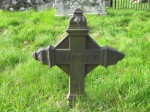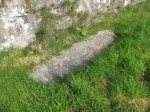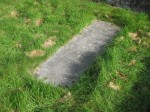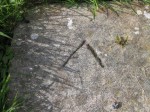Memorial stone to John Stewart
Memorial stone to James Fraser

Kirsty's Cross

The small flat stone left of the gate

The large flat stone

The "Arrow" stone

The "Arrow" mark
| Return to Home Page |
Strathtummel in Past Times |
Details of Borenich Homesteads | Finding Your Ancestors | Parish of Blair Atholl Gazetteer |
Photo Gallery | Index to Website Information | Latest Web-site Additions |
|---|
There is scant information concerning the origins of the Borenich Burial Ground, or to the names of the people buried in it.
The Dundee Courier carried the following article in December 1974:
In November 1982 Duncan Douglas, whose family originally came from Borenich, wrote the following in a letter:
The same story of the burial ground was independently passed down through the Stewart family by Rita Merrie, and matches this account.
Alexander Stewart was the youngest son of John "Bonnety" Stewart of Balcastle, whose memorial stone is beside the gate. John Stewart and his family lived at Balcastle until about 1852, after which they moved to Bankfoot, near Perth. John became the landlord of the Diamond Inn at Bankfoot and was locally known as "Bonnety" on account of his headgear. When John Stewart died in 1884 he requested in his will, "that his mortal remains should be interred in the churchyard of Barrauch (Borenich)". It is quite likely that many of his ancestors, who lived around Balcastle for generations before, are also buried in the same place.
The last person to be buried in the burial ground was Alexander Stewart's elder brother, John, who was a cabinet maker in Edinburgh. As an example of Highland hospitality it is recounted that:
Even John's funeral was a Highland event never to be forgotten.
In addition to the Stewart stone and the Fraser stone, there are three flat slabs without inscription - this is not surprising as it should be remembered that right up until the 1950s there were native Gaelic speakers in Strathtummel. Indeed, within living memory, some like Donald McDonald of Chamberbane spoke no other language.
The first flat stone is just inside the gate, on the left, next to the wall. Its small size may indicate the burial of a child. The second flat stone is towards the opposite corner of the enclosure and is the largest of the three slabs. It also appears to be the most recent. There is a possibility that it marks the grave of Robert Stewart, John "Bonnety" Stewart's father. The third flat stone was discovered in the north-east corner in 1986, covered by four to five inches of soil. When this stone was returned to the surface it was noticed that there was an "arrow" mark cut into its upper surface. The significance of this "arrow" mark is unknown, but may indicate that the stone had a different function, prior to being used as a gravestone.
The original walls were probably constructed as a drystone dyke, and the 1851 census shows that John Stewart, himself, was a dyke contractor. It is thought that the walls were first mortared when Alexander Stewart carried out the repairs. The workmen did an excellent job, as the walls survived the harsh Scottish winters until 2006, before the process of re-pointing the mortar became neccessary. A close inspection of the entrance shows that the present gate is not the original. There are two short metal stubs on either side of the present gate, as well as a bolt-hole drilled into the entrance step, which must have been used to secure the original gate.
| Return to Home Page |
|---|